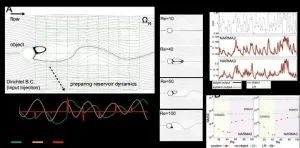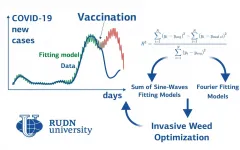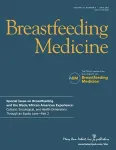(Press-News.org) [Background]
In recent years, physical reservoir computing*1), one of the new information processing technologies, has attracted much attention. This is a physical implementation version of reservoir computing, which is a learning method derived from recurrent neural network (RNN)*2) theory. It implements computation by regarding the physical system as a huge RNN, outsourcing the main operations to the dynamics of the physical system that forms the physical reservoir. It has the advantage of obtaining optimization instantaneously with limited computational resources by adjusting linear and static readout weightings between the output and a physical reservoir without requiring optimization of the weightings by back propagation. However, since the information processing capability depends on the physical reservoir capacity, it is important that this is investigated and optimized. Furthermore, when designing a physical reservoir with high information processing capability, it is expected that the experimental cost will be reduced by numerical simulation.
Well-known examples of physical reservoir computing include its application to soft materials, photonics, spintronics, and quanta, while in recent years, much attention has been paid to waves; neuromorphic devices that simulate functions of the brain by using non-linear waves have been proposed (see references 1-3). The fluid flow of water, air, etc. represents a physical system that is familiar but shows various and complicated patterns that have been thought to have high information processing capability. However, virtual physical reservoir computing using numerical simulation or investigation of information processing capability of fluid flow phenomena has not been realized due to its relatively high numerical computational cost. Therefore, the relationship between the flow vortex and information processing capability remained unknown.
[Results]
In this study, Prof. Hirofumi Notsu and a graduate student of Kanazawa University in collaboration with Prof. Kohei Nakajima of the University of Tokyo investigated fluid flow phenomena as a physical system, especially the fluid flow that occurs around a cylinder, which is well understood. It is known that this physical system is governed by the incompressible Navier-Stokes equations*3), which describe fluid flow, and also includes the Reynolds number*4), a parameter indicative of the system characteristics. This physical system was virtually implemented by spatial two-dimensional numerical simulation using the stabilized Lagrange-Galerkin method*5), and the dynamics of flow velocity and pressure at the selected points in the downstream region of the cylinder were used as the physical reservoir. The information processing capability was evaluated using the NARMA model*6) (see Figure).
It is known that in the flow of fluid around a cylinder, as the Reynolds number value increases, twin vortices formed in the downstream region of the cylinder gradually become larger and eventually form a Karman vortex street, the alternate shedding of vortices. In this study, it was clarified that at the Reynolds number where the twin vortices are maximal but just before the transition to a Karman vortex street, the information processing capability is the highest. In other words, before the transition to a Karman vortex street, the information processing capability increases as the size of the twin vortices increases. On the other hand, since the echo state property*7) that guarantees the reproducibility of the reservoir computing cannot be maintained when the transition to the Karman vortex street takes place, it becomes clear that the Karman vortex street cannot be used for computing.
[Future prospects]
It is expected that these findings concerning fluid flow vortices and information processing capability will be useful when, in future, the information processing capability of the physical reservoir can be expanded using fluid flow, e.g. in the development of wave-based neuromorphic devices recently reported. Although the numerical computational cost of fluid flow phenomena is relatively high, this study has made it possible to handle macroscopic vortices that are physically easy to understand and has clarified the relationship between vortices and information processing capabilities by virtually implementing physical reservoir computing with spatial two-dimensional numerical simulation. Virtual physical reservoir computing, which used to be applied to a relatively large number of physical systems described as one-dimensional systems, has been expanded to include physical systems with two or more spatial dimensions. It is expected that the results of this study will allow the virtual investigation of the information processing capabilities of a wider range of physical systems. In addition, since it is revealed that vortices are the key to information processing capability, it is expected that research for creating or maintaining vortices will be further promoted.
INFORMATION:
[Glossary]
*1) Physical reservoir computing
A physical implementation version of reservoir computing, which is a type of learning method for recurrent neural networks (RNN). The dynamics of a physical system (physical reservoir) is regarded as a huge RNN, with which major computing is performed. Since it outsources operations, it has the advantage of being able to obtain optimization instantaneously with limited computational resources.
*2) Recurrent neural network (RNN)
A recurrent neural network is a neural network in which the output of the middle layers is also the input of itself or another layer.
*3) Incompressible Navier-Stokes equations
Incompressible Navier-Stokes equations are partial differential equations concerning the velocity and pressure of fluid flow in which the material density is constant.
*4) Reynolds number
Reynolds number (Re) is a dimensionless number that represents the ratio of the inertial force and the viscous force of the flow where ν is the kinematic viscosity of the fluid (m2/s), U is the flow speed (m/s), and L is the characteristic linear dimension (m), Re = UL/ν.
*5) Stabilized Lagrange-Galerkin method
A numerical solution of the finite element method. An implicit finite element method in which Lagrangian coordinates are used for the inertial term, piecewise linear elements are used to approximate the fluid flow velocity and pressure for the incompressible Navier-Stokes equations, and pressure stabilization is applied. It is characterized by robustness with respect to convection, relatively small numerical diffusion, and a symmetric matrix.
*6) NARMA model
NARMA (Nonlinear Autoregressive Moving Average) model, a non-linear time series model with inputs. In NARMA2, the next value is determined by the present and previous time values and input values. In NARMA3, it also depends on the value at the pre-previous time and input values.
*7) Echo state property
The property that the internal state of the current reservoir is expressed as a function that depends only on past inputs (it does not depend on the initial value). As a result, reservoirs with this property will eventually synchronize if the same inputs are given continuously, even if they start from different states.
[References]
1. Marcucci, G., Pierangeli, D., Conti, C., Theory of neuromorphic computing by waves: Machine learning by Rogue Waves, Dispersive Shocks, and Solitons, Phys. Rev. Lett., 125, 093901 (2020).
2. Silva, N. A., Ferreira, T. D., Guerreiro, A., Reservoir computing with solitons, New Journal of Physics, 23, 023013 (2021).
3. Hughes, T. W., Williamson, I. A., Minkov, M., Fan, S. Wave physics as an analog recurrent neural network. Science Advances, 5, eaay6946 (2019).
SINGAPORE, 17 June 2021 - New details on the structure and function of a transport protein could help researchers develop drugs for neurological diseases that are better able to cross the blood-brain barrier. The findings were published in the journal Nature by researchers at Columbia University Vagelos College of Physicians and Surgeons, Duke-NUS Medical School, Weill Cornell Medicine and colleagues.
Omega-3 fatty acids, like docosahexaenoic acid (DHA), are important for brain and eye development. They are derived mainly from dietary sources and converted ...
New research presents over 300 new analyses of bronze objects, raising the total number to 550 in 'the archaeological fingerprint project'. This is roughly two thirds of the entire metal inventory of the early Bronze Age in southern Scandinavia. For the first time, it was possible to map the trade networks for metals and to identify changes in the supply routes, coinciding with other socio-economic changes detectable in the rich metal-dependent societies of Bronze Age southern Scandinavia.
The magnificent Bronze Age in southern Scandinavia rose from copper traded from the British Isles and Slovakia 4000 years ago. 500 ...
In a paper published in NANO, a team of researchers from Jiangnan University, China have prepared a convenient sensing platform which can detect microRNA-205 (MiR-205) with high sensitivity and excellent selectivity using TpTta-COF nanosheet and fluorescent oligonucleotide probes.
Nasopharyngeal carcinoma (NPC) is a kind of malignant cancer derived from the epithelial cells, which shows an apparent regional aggregation with a high prevalence in Southern China and Southeast Asia. With the ongoing improvement of radiotherapy technology, the therapeutic effect of NPC patients has been increased significantly. However, the easy recurrence and metastasis still cause the poor prognosis of NPC patients. Many researches indicated that ...
RUDN University mathematicians built a model of COVID-19 spreading based on two regression models. The mathematicians divided the countries into three groups, depending on the spreading rate and on the climatic conditions, and found a suitable mathematical approximation for each of them. Based on the model, the mathematicians predicted the subsequent waves. The forecast was accurate in countries where mass vaccination was not introduced. The results are published in Mathematics.
The epidemy spreading rate within the country depends, among other things, on the climatic ...
In recent years, significant progress has been made towards the use of high-resolution peripheral computed tomography (HR-pQCT) imaging in research, and new potential for applications in the clinic have emerged, particularly with the advent of second generation devices.
A newly published state-of-the-art publication on the use and future directions of HR-PQCT provides a concise overview of current clinical applications as well as valuable guidance on the interpretation of results.
Specifically, it gives an overview of:
differences and reference data for HR-pQCT variables by age, sex, body composition and race/ethnicity;
fracture risk prediction using HR-pQCT, specifically in regard to bone microarchitecture in individuals ...
AURORA, COLORADO, June 16, 2021 -- Foresight Diagnostics, the emerging leader in blood-based lymphoma disease monitoring, announced today that clinical performance of its minimal residual disease (MRD) detection platform in diffuse large B-cell lymphoma (DLBCL) will be presented at the 16th International Conference on Malignant Lymphoma (ICML) on June 18-22, 2021. The oral presentation demonstrates the utility of Foresight Diagnostics' proprietary PhasED-Seq technology to improve MRD detection rates in DLBCL patients in low-disease burden settings.
"Foresight's MRD testing platform can detect relapsing disease 200 ...
Cancer cells can develop resistance to therapy through both genetic and non-genetic mechanisms. But it is unclear how and why one of these routes to resistance prevails. Understanding this 'choice' by the cancer cells may help us devise better therapeutic strategies. Now, the team of Prof. Jean-Christophe Marine (VIB-KU Leuven Center for Cancer Biology) shows that the presence of certain stem cells correlates with the development of nongenetic resistance mechanisms. Their study is published in the prestigious journal Cancer Cell.
Two routes to resistance
Even though cancer therapy has made great strides in the ...
African American mothers continue to have the lowest breastfeeding rates, even as the breastfeeding rates have risen in the U.S. over the past 25 years. Racism is an important barrier to breastfeeding, as examined in Part 2 of a special issue on "Breastfeeding and the Black/African American Experience: Cultural, Sociological, and Health Dimensions Through an Equity Lens," published in the peer-reviewed journal Breastfeeding Medicine. Click here to read the issue now.
The special issue is led by Guest Editor Sahira Long, MD, a pediatrician and lactation consultant.
Exploring how racism creates barriers to breastfeeding for Black mothers and how Black women resist racism during their quest to breastfeed are Catasha Davis, PhD and Aubrey Van Kirk Villalobos, DrPH, Milken Institute School ...
Since 2005, the guidelines for the care of unconscious cardiac arrest patients have been to cool the body temperature down to 33 degrees Celsius. A large, randomised clinical trial led by Lund University and Region Skåne in Sweden has shown that this treatment does not improve survival. The study is published in the New England Journal of Medicine.
"These results will affect the current guidelines", says Niklas Nielsen, researcher at Lund University and consultant in anaesthesiology and intensive care at Helsingborg Hospital, who led the study.
In the early 2000s, two studies in the New England Journal of Medicine showed that induced hypothermia in unconscious cardiac arrest patients ...
Conservationists have long warned of the dangers associated with bears becoming habituated to life in urban areas. Yet, it appears the message hasn't gotten through to everyone.
News reports continue to cover seemingly similar situations -- a foraging bear enters a neighbourhood, easily finds high-value food and refuses to leave. The story often ends with conservation officers being forced to euthanize the animal for public safety purposes.
Now, a new study by sustainability researchers in the Irving K. Barber Faculty of Science uses computer modelling to look at the best strategies to reduce human-bear conflict.
"It happens all the time, and unfortunately, humans are almost ...




